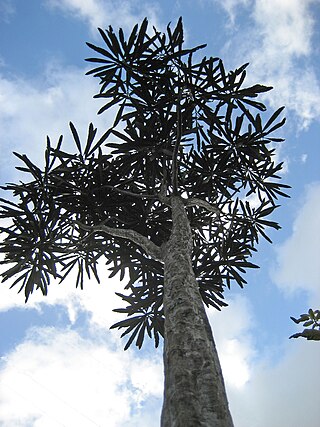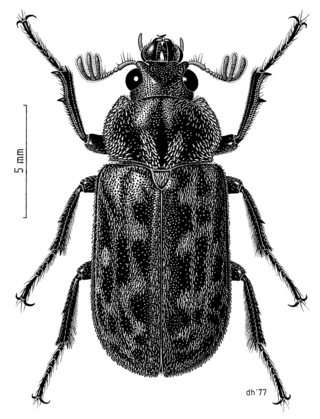
Podocarpus totara, commonly known as the tōtara, is a species of podocarp tree endemic to New Zealand. It grows throughout the North Island, South Island and rarely on Stewart Island / Rakiura in lowland, montane and lower subalpine forest at elevations of up to 600 m.

Pseudopanax crassifolius, also known as horoeka or lancewood, is a heteroblastic tree belonging to the family Araliaceae. It is endemic to New Zealand and found throughout the country from sea level up to about 750 m in lowland to montane shrublands and forests.

Pennantia baylisiana, commonly known as Three Kings kaikōmako or kaikōmako manawatāwhi (Māori), is a species of plant in the family Pennantiaceae. It is endemic to Manawatāwhi / Three Kings Islands, around 55 kilometres (34 mi) northwest of Cape Reinga, New Zealand. At the time of its discovery just one plant remained. This single tree grows on a scree slope inaccessible to browsing goats, and has been called "the world's loneliest tree". The species was discovered in 1945 by botanist Geoff Baylis and described in 1948, although it took decades before it was it was fully accepted as a distinct species of Pennantia. Although the only wild tree is female, it was successfully propagated from cuttings in the 1950s, one of which was induced to self-pollinate in 1985. Subsequent seed-grown plants have themselves set seeds, and the species has been replanted on the island, the adjoining mainland, and in public and private gardens around New Zealand.

Phormium tenax is an evergreen perennial plant native to New Zealand and Norfolk Island that is an important fibre plant and a popular ornamental plant. The plant grows as a clump of long, straplike leaves, up to two metres long, from which arises a much taller flowering shoot, with dramatic yellow or red flowers.

Armillaria limonea is a species of mushroom in the family Physalacriaceae. This plant pathogen species is one of four Armillaria species that have been identified in Aotearoa New Zealand the others are A. novae-zelandiae,A. hinnulea, A. aotearoa).

The New Zealand Arthropod Collection is a collection of terrestrial invertebrates held by Maanaki Whenua – Landcare Research in Auckland, New Zealand. It specialises in the taxonomy and identification of indigenous and exotic invertebrate species in New Zealand, and is one of New Zealand's Nationally Significant Collections and Databases.

Izatha balanophora is a moth of the family Oecophoridae. It is endemic to New Zealand, where it is widespread in the North Island. Larvae live off the dead bark of kānuka. The adult moths are on the wing during December to March.

Elatostema rugosum is an herbaceous dicot that is considered to be a groundcover. It is commonly called parataniwha, paratāniwhaniwha, New Zealand begonia, and begonia fern. It tends to grow in large masses. Although it has hairs and is in the nettle family, it does not possess any stinging hairs.

Ericodesma cuneata, the Corokia leafroller moth, is a species of moth in the family Tortricidae. It is endemic to New Zealand. This moth is classified as "At Risk, Naturally Uncommon" by the Department of Conservation.

Myrsine divaricata also known as weeping māpou or weeping matipo, is a small tree up to 4 metres (13 ft) tall or often a shrub endemic to New Zealand. It has a strongly divaricating habit with interlaced branches. The woody parts are stiff and pubescent when young. The small leathery simple leaves are borne on short petioles and may be slightly two lobed at the end. The very small yellow or reddish flowers may be borne singly or in small groups which mature into small purple, occasionally white, fruit.

Pimelea actea is a small coastal plant native to New Zealand. It was named and described by Colin J. Burrows in 2008 as part of a revision of the New Zealand Pimelea, a project he had begun as a Master's thesis in the 1950s and continued in his retirement. Burrows described the species, which for some time had been referred to as Pimelea "Turakina", from a specimen collected in 1968, now in the Auckland Museum. Its species name, actea, means "coastal".

Notoreas isoleuca is a species of moth in the family Geometridae. It is endemic to New Zealand.

Notoreas isomoera is a species of moth in the family Geometridae. It is endemic to New Zealand.
The New Zealand Nationally Significant Collections and Databases (NSCDs) are government-funded biological and physical collections or databases that are considered important and significant to New Zealand.
Riria Smith was a master in traditional Māori weaving from Northland in New Zealand. She was affiliated to the iwi Ngāti Kurī and the hapū Pohutiare of Te Aupōuri.

Priscilla M. Wehi is a New Zealand ethnobiologist and conservation biologist. As at July 2021 she is an associate professor at the University of Otago and on the first of that month officially undertook the role of director of Te Pūnaha Matatini, a centre of research excellence in complex systems and data analytics. During the COVID-19 pandemic in New Zealand Te Pūnaha Matatini scientists have developed mathematical models of the spread of the virus across the country that influence the New Zealand government's response to the outbreak. In 2021 Wehi was awarded the Hill Tinsley Medal.
The New Zealand Fungarium (PDD): Te Kohinga Hekaheka o Aotearoa is the major collection of New Zealand fungi. It is one of the largest collections in the Southern Hemisphere. The Fungarium is designated a Nationally Significant Collection by the Ministry of Business, Innovation and Employment.
Artystona is a genus of insects in the darkling beetle family Tenebrionidae. Adults hide during the day in dead wood or under loose bark, and emerge at night to feed on epiphytic lichens. They are unique among New Zealand tenebrionids for this behaviour. There are six recognised species, which are endemic to New Zealand.
















